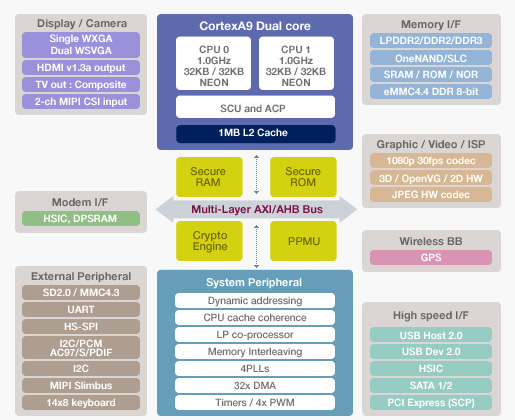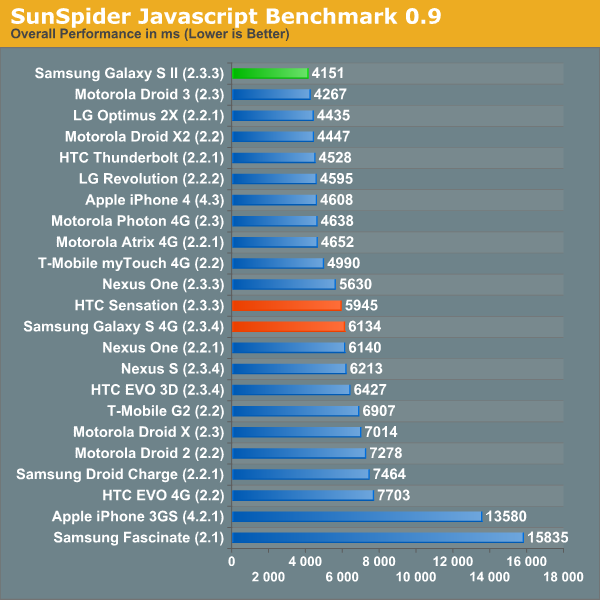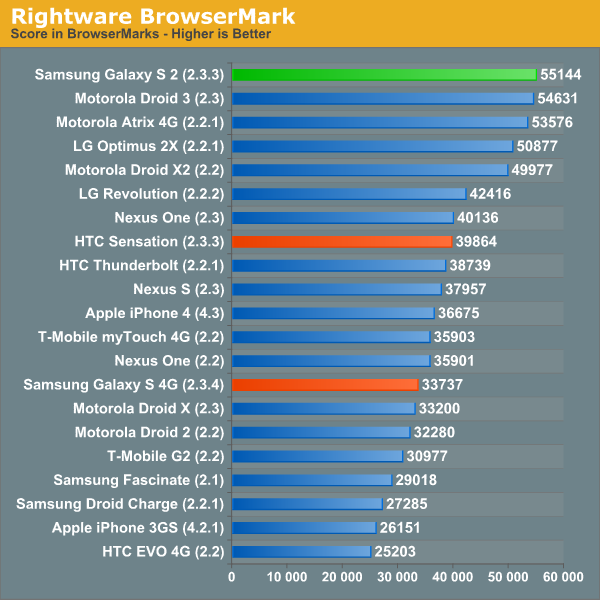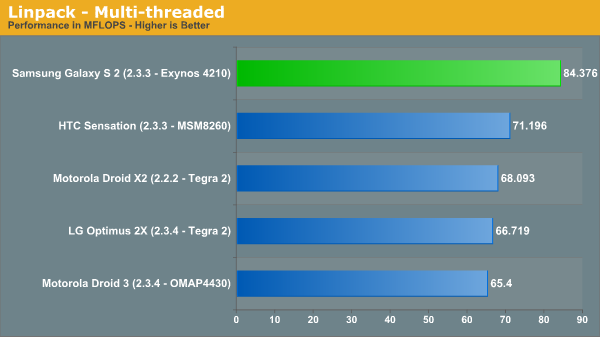Samsung Galaxy S 2 (International) Review - The Best, Redefined
by Brian Klug & Anand Lal Shimpi on September 11, 2011 11:06 AM EST- Posted in
- Smartphones
- Samsung
- Galaxy S II
- Exynos
- Mobile
The Fastest Smartphone SoC Today: Samsung Exynos 4210
Samsung has been Apple's sole application processor supplier since the release of the original iPhone. It's unclear how much Samsung contributes to the design process, especially with later SoCs like the A4 and A5 carrying the Apple brand. It's possible that Samsung is now no more than a manufacturing house for Apple.
Needless to say, the past few years of supplying SoCs for the iPhone and iPad have given Samsung a good idea of what the market wants from an application processor. We first got the hint that Samsung knew what it was up to with its Hummingbird SoC, used in the Galaxy S line of smartphones.
Hummingbird featured a 1GHz ARM Cortex A8 core and an Imagination Technologies PowerVR SGX 540 GPU. Although those specs don't seem very impressive today, Hummingbird helped Samsung ship more Android smartphones than any of its competitors in 2010. At a high level, Hummingbird looked a lot like Apple's A4 used in the iPad and iPhone 4. Its predecessor looked a lot like Apple's 3rd generation SoC used in the iPhone 3GS.
Hummingbird's successor however is Samsung's first attempt at something different. This is the Exynos 4210 application processor:

We first met the Exynos back when it was called Orion at this year's Mobile World Congress. Architecturally, the Exynos 4210 isn't too far from Apple's A5, NVIDIA's Tegra 2 or TI's OMAP 4. This is the same CPU configuration as all of the aforementioned SoCs, with a twist. While the A5, Tegra 2 and OMAP 4 all have a pair of ARM Cortex A9 cores running at 1GHz, Exynos pushes the default clock speed up to 1.2GHz. Samsung is able to hit higher clock speeds either through higher than normal voltages or as a result of its close foundry/design relationship.

Exynos 4210 with its PoP LPDDR2
ARM's Cortex A9 has configurable cache sizes. To date all of the A9 implementations we've seen use 32KB L1 caches (32KB instruction cache + 32KB data cache) and Samsung's Exynos is no exception. The L2 cache size is also configurable, however we haven't seen any variance there either. Apple, NVIDIA, Samsung and TI have all standardized on a full 1MB L2 cache shared between both cores. Only Qualcomm is left with a 512KB L2 cache but that's for a non-A9 design.

Where we have seen differences in A9 based SoCs are in the presence of ARM's Media Processing Engine (NEON SIMD unit) and memory controller configuration. Apple, Samsung and TI all include an MPE unit in each A9 core. ARM doesn't make MPE a requirement for the A9 since it has a fully pipelined FPU, however it's a good idea to include one given most A8 designs featured a similar unit. Without MPE support you run the risk of delivering an A9 based SoC that occasionally has lower performance than an A8 w/ NEON solution. Given that Apple, Samsung and TI all had NEON enabled A8 SoCs in the market last year, it's no surprise that their current A9 designs include MPE units.
NVIDIA on the other hand didn't have an SoC based on ARM's Cortex A8. At the same time it needed to be aggressive on pricing to gain some traction in the market. As a result of keeping die size to a minimum, the Tegra 2 doesn't include MPE support. NEON code can't be executed on Tegra 2. With Tegra 3 (Kal-El), NVIDIA added in MPE support but that's a discussion we'll have in a couple of months.
Although based on Qualcomm's own design, the Snapdragon cores include NEON support as well. Qualcomm's NEON engine is 128-bits wide vs. 64-bits wide in ARM's standard implementation. Samsung lists the Exynos 4210 as supporting both 64-bit and 128-bit NEON however given this is a seemingly standard A9 implementation I believe the MPE datapath is only 64-bits wide. In other words, 128-bit operations can be executed but not at the same throughput as 64-bit operations.
The same designs that implemented MPE also implemented a dual-channel memory controller. Samsung's Exynos features two 32-bit LPDDR2 memory channels, putting it on par with Apple's A5, Qualcomm's Snapdragon and TI's OMAP 4. Only NVIDIA's Tegra 2 features a single 32-bit LPDDR2 memory channel.
| ARM Cortex A9 Based SoC Comparison | ||||||
| Apple A5 | Samsung Exynos 4210 | TI OMAP 4 | NVIDIA Tegra 2 | |||
| Clock Speed | Up to 1GHz | Up to 1.2GHz | Up to 1GHz | Up to 1GHz | ||
| Core Count | 2 | 2 | 2 | 2 | ||
| L1 Cache Size | 32KB/32KB | 32KB/32KB | 32KB/32KB | 32KB/32KB | ||
| L2 Cache Size | 1MB | 1MB | 1MB | 1MB | ||
| Memory Interface | Dual Channel LP-DDR2 | Dual Channel LP-DDR2 | Dual Channel LP-DDR2 | Single Channel LP-DDR2 | ||
| NEON Support | Yes | Yes | Yes | No | ||
| Manufacturing Process | 45nm | 45nm | 45nm | 40nm | ||
Like most of its competitors, Samsung's memory controller does allow for some flexibility when choosing memory types. In addition to LPDDR2, the Exynos 4210 supports standard DDR2 and DDR3. Maximum data rate is limited to 800MHz regardless of memory type.
Based on everything I've said thus far, the Exynos 4210 should be among the highest performing SoCs on the market today. It has the same clock for clock performance as an Apple A5, NVIDIA Tegra 2 and TI OMAP 4430. Samsung surpassed those designs by delivering a 20% higher operating frequency, which should be tangible in typical use.
To find out let's turn to our CPU performance suite. We'll start with our browser benchmarks: SunSpider and BrowserMark:


Despite the 20% clock speed advantage the Galaxy S 2 isn't any faster than Motorola's Droid 3 based on a 1GHz TI OMAP 4430. Unfortunately this doesn't tell us too much since both benchmarks take into account browser performance as well as total platform performance. While the Galaxy S 2 is clearly among the fastest smartphones we've ever reviewed it looks like Motorola's browser may actually be a bit more efficient at javascript execution.
Where we do see big gains from the Exynos' higher clock speed is in our Linpack tests. The single-threaded benchmark actually shows more scaling than just clock speed, indicating that here are other (possibly software?) factors at play here. Either way it's clear that the 20% increase in clock speed can surface as tangible if the conditions are right:


A clock speed advantage today is nice but it's something that Samsung's competitors will be able to deliver in the not too distant future. Where Samsung chose to really differentiate itself was in the graphics department. The Exynos 4210 uses ARM's Mali-400 MP4 GPU.
Shipping in smartphones today we have GPUs from three vendors: Qualcomm (Adreno), Imagination Technologies (PowerVR SGX) and NVIDIA (GeForce). Of those vendors, only Qualcomm and NVIDIA produce SoCs - Imagination simply licenses its technology to SoC vendors.
Both Apple and Intel hold significant amounts of Imagination stock, presumably to protect against an eager SoC vendor from taking control of the company.
ARM also offers GPU IP in addition to its CPU designs, however we've seen very little uptake until now. Before we get to Mali's architecture, we need to talk a bit about the different types of GPUs on the market today.










132 Comments
View All Comments
shamalh108 - Monday, September 12, 2011 - link
Thanks alot, going to do that today, however if you read my post above im not sure its an individual app causing it. Maybe i should root so i can wipe the battery stats and recalibrate, besides that im also going to purchase the offical extended battery from samsung, i dont mind losing slight slimness:)ph00ny - Monday, September 12, 2011 - link
I didn't even bother with rooting for a month or two until i wanted to try out chainfire plugins. Even in stock form, battery life was great. certainly better than my captivate.One thing to understand about SAMOLED screen is that it uses 0 power on black pixel and more power on white pixels. So maybe try out a darker themed wall paper and also check to see if you have widgets that have tendency to use up more juice than an alternative
Also for an example, samsung's stock music app uses roughly half of Google's music app power consumption. It gets worse with spotify (offline mode of course)
Remeniz - Monday, September 12, 2011 - link
The trick is to adjust the power saving features to suit and make sure very little is going on in the back ground. I only run GPS if I need too and the WiFi gets turned off when i'm out and about, unless I know i'm in a WiFi zone and want to browse the www.I get at least a days use out of my SGS2.
supercurio - Monday, September 12, 2011 - link
Note:"When idle, processor goes back to 200 MHz"
Idle - screen on or an using a wakelock to keep the device on its the case.
Otherwise the whole CPU is turned literally OFF − everything frozen in RAM.
And in this situation, the baseband, Wi-fi chip or an external timer will wake up the CPU and restore Linux kernel in a working state when needed, like if you received a new mail, or a phone call.
I precise that because most people believe the CPU stays ON all the time but it's the opposite, with standard usage, the CPU is ON only a fraction of the day.
Lucian Armasu - Sunday, September 11, 2011 - link
Brian, I don't think it's fair to compare the "tablet" version of A5 with the "smartphone" version of the Exynos and all the other chips. Even Nvidia's Tegra 2 has either 50% or 100% higher clock frequency for its GPU in the tablets, compared to the one in smartphones.It's very likely that all tablet chips are more powerful than the smartphones ones, and for all we know the iPhone 5 GPU will only one 1 GPU core instead of 2 like in the iPad 2, or they'll be clocked at a lower frequency.
I know you'll review the iPhone 5, too, but I think you're setting a too low expectation for the Exynos and the others compared to the "A5 chip". You know what I mean? You should've at least thrown a Xoom or a Transformer in there to see how it fairs against the Tegra 2 phones.
I hope at least you'll correct this in future reviews. Great review otherwise, though.
privater - Sunday, September 11, 2011 - link
An iPad 2 can run sun spider 0.9 with 1980 score (4.3.5)If the Exynos is superior on every aspect of A5, the result is difficult for me to understand.
Lucian Armasu - Sunday, September 11, 2011 - link
Just as I mentioned above, it's not fair to compare the tablet versions with the phone versions of the chips. All the latest smartphones get around 4000 in the Sun Spider test, but all tablets get around 2000 in that test, so even on the CPU side, it's still not a fair comparison.Mike1111 - Sunday, September 11, 2011 - link
Great review!But why are you so late with the review of the INTERNATIONAL version? I mean I would get it if you decided to wait for the US versions, but waiting almost 4 1/2 months and then publish a review of the international version only a week before the US versions get released? Seems strange to me...
ph00ny - Sunday, September 11, 2011 - link
Brian said in the other reviews comment sections that he was waiting to get ahold of a review unit. I did offer mine if he was nearby but he's nearly on the west coast and i live in the opposite side of the countryshamalh108 - Sunday, September 11, 2011 - link
Another pity is that even games from gameloft which are supposed to be adapted to the SGS2 cause significant heating of the phone.. for example the Asphalt 6 available for free in Samsung Apps .. it would be great if more games were coded to make better use of the SGS2 gpu ...